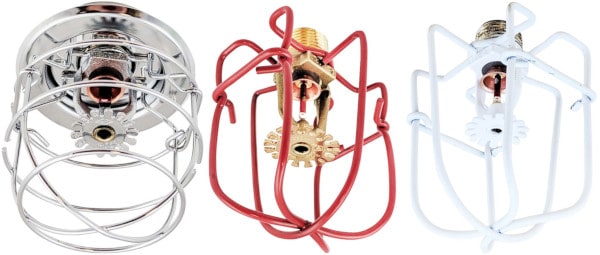Major fire protection standards don’t require a color—but required listings, safety concerns, and other factors suggest some possibilities
Very rarely do fire sprinklers spray for no reason. It’s much more likely for unprotected heads to discharge after an impact from a ladder, broom, soccer ball, forklift, pallet, or even an act of vandalism. For reasons like these, people often place fire sprinkler head guards (also called “sprinkler head cages”) between heads and anticipated sources of collisions.
One question we’re often asked: are there color requirements for sprinkler head guards? Which finishes are best? The short answers to these questions are “no” and “it depends.”
Fire safety standards may limit the choices of head guards available—and indirectly limit the selection of in-stock colors retailers can provide. In other instances, aesthetic concerns, fear of vandalism, or a desire to prevent unintentional collision can serve as a guide. To learn more, read on.
If you’d like, you can browse our full selection of fire sprinkler head guards, including recessed, standard, and heavy-duty models.
A fire sprinkler head guard’s purpose and local fire codes may limit the options available
Fire code is largely the domain of local and state governments. State, county, or city rules—rather than one unified national standard—legally prescribe the components needed for a sprinkler system. Many of those rules are based on codes and standards from the National Fire Protection Association (NFPA), however, including NFPA 13: Standard for the Installation of Sprinkler Systems.
And when it’s likely that some object may collide with a fire sprinkler, NFPA 13 requires the installation of protective head guards.
From the 2019 edition of NFPA 13
16.2.6 Sprinklers subject to mechanical injury shall be protected with listed guards.
These guards, which typically consist of finished or coated metal wire, can protect sprinklers against impact in areas with low clearance. They may also buy time when larger objects enter on a (very) slow collision course with heads. However, most guards only protect against limited force. Apart from heavy-duty head guards, which use larger steel cages to protect against hard hits, most standard guards exist simply to keep otherwise mild impacts from breaking the most fragile parts of a sprinkler head.
Notably, NFPA 13 also specifies that each guard used to protect against mechanical injury should be “listed.” These listings tell purchasers, installers, and local fire authorities that the head guard has been tested and/or evaluated with the specific sprinkler it protects.
On the other hand, where head guards are added for reasons other than compliance with NFPA 13—such as occasional light impacts or temporary protection—non-listed or generic head guards may suffice if they are approved by the authority having jurisdiction (AHJ; often your local fire marshal or other code enforcement office). The key here is that any head guard must not interfere with the sprinkler’s operation or spray pattern. Before we go any further, let’s outline some definitions:
Manufacturer-specific head guards are those that a manufacturer (Tyco, Viking, Reliable, Victaulic) has made specifically for their sprinklers. These are always listed and compliant with NFPA 13 systems and they only come in the standard, smaller sizes that may protect fragile sprinkler head parts from incidental impact, but don’t protect against harder, heavier impacts.
Generic head guards are those not made by one of the major sprinkler manufacturers. They may or may not be listed. Generic head guards come in either standard or heavy-duty sizes. Heavy-duty sizes can handle much harder hits, such as a hurtling basketball and may even slow down the impact of a glancing blow from a forklift enough to avoid setting off the sprinkler. Heavy-duty head guards are not listed, however, so getting the approval of your AHJ is strongly advised.
For the most part, generic sprinkler head cages are made with more stock finishes than listed ones
When listed guards are needed, the only guaranteed options are generally provided by the manufacturer. Some third-party groups go to the trouble of having their generic fire sprinkler head guards listed for use with for brand-name sprinklers—but many don’t. As a result, when listings are required (and again, check with your AHJ), installers and consumers will likely need manufacturer-specific head guards: Tyco-brand guards for Tyco sprinklers, Viking-brand guards for Viking sprinklers, and so on.
This intersection between listing requirements and manufacturers’ stock often leaves consumers with few color choices for fire sprinkler head guards. Victaulic, Viking, and Reliable (RASCO) offer one stock color for their head guards: chromate over zinc. Tyco offers a few more stock finishes, including brass, red, chrome, zinc coated, and zinc chromate. And one other major manufacturer, Senju Sprinkler, offers no listed head guards.
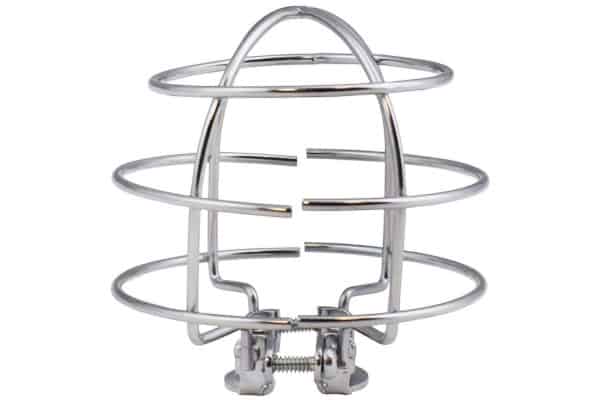
The options for non-listed or generic fire sprinkler cages are, by comparison, a little more varied. Many guards will secure to most fire sprinklers with both 1/2” and 3/4” thread connections—by far the most common sizes. Finishes like white, red, and chrome are readily available for these generic standard head guards.
As we’ve noted in our guide to head guards, the key consideration is whether or not the sprinkler is recessed. If its end mounts flush against the wall or ceiling—the sprinkler head body is completely exposed—standard head guards should suffice. If the cup or plate it sits in is recessed (sits slightly behind the wall or ceiling), the cage should be recessed.
Heavy-duty head guards are available in black, red, yellow, and white for exposed sprinkler heads in different orientations.
Inconspicuous sprinkler head cages may allay fears of vandalism or address aesthetic concerns, but warning colors may help prevent collisions in the first place
For consumers worried more about the potential for water damage than the head guard’s appearance, the first question to ask is: is the likeliest source of damage intentional or unintentional? Both are among the top five causes of discharges and leaks in fire sprinkler systems. Also, what (if any) aesthetic considerations matter?
White may be the go-to aesthetic choice in most commercial buildings, although chrome may be consistent with existing sprinklers
The most common colors for fire sprinklers (by far) are chrome, white, and brass. To take an example from our own stock of commercial heads: as of September 2019, 38% have a brass finish, 28% are chrome, and 24% are white—with the remainder being either black or concealed by a protective cover plate. In residential applications, our most sought-after finish is white.
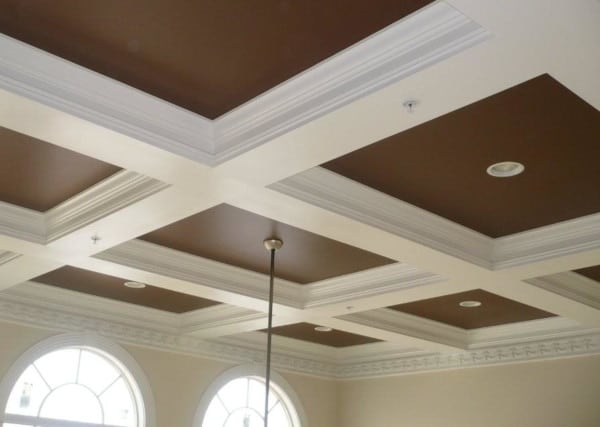
In many cases, the best aesthetic choice may be to choose a sprinkler head cage with the color that most closely matches the adjacent wall or ceiling. White fire sprinkler head guards provide that match for most ceilings and, in some instances, for walls. In other cases, consistency with existing heads may be desired. White- or chrome-finished sprinklers may quickly be matched with white head guards or chrome head guards. Brass sprinklers are slightly more difficult: Tyco may be the only major fire sprinkler manufacturer to offer brass as a head guard finish to match their brass fire sprinklers.
High-contrast head guard colors may reduce collisions by making people more aware of sprinklers
Earlier this year, we spoke with Product Design Specialties—an Oregon-based company specializing in hazard mitigation equipment—about the design of their extra-large, heavy-duty head guards. Patrick O’Banion, the company’s founder, explained his belief that bright colors can play a role in protecting sprinkler heads:
“We set out to make a head guard big enough to where it can be recognized, so maybe it wouldn’t be hit in the first place. Plus, that’s why we offer it in brighter colors. We do sell a lot of yellow for industrial applications. Because it’s visible. Highly visible.”
What constitutes “highly visible” is a somewhat subjective matter. However, VisionAware, an informational resource for adults with vision loss, offers some more concrete suggestions that could apply to fire sprinkler head guards. In “Contrast and Color,” certified vision rehabilitation therapist Maureen A. Duffy notes that a patternless, bright color—like red, orange, or yellow—can better reflect light. Further, placing brighter objects against darker backgrounds (or darker objects against lighter backgrounds) creates contrast and enhances visibility.
Consumers can see concern over color at work with fire extinguishers and their covers. The Occupational Health and Safety Administration (OSHA) requires some employers to follow a specific color-coding scheme for hazardous equipment and emergency gear, with red serving as OSHA’s color for “fire protection equipment and apparatus.”
To put this information together: red may be a great color for fire sprinkler head guards where an accidental collision is likely. It’s used in fire protection, has high-visibility characteristics, and—crucially—is readily available. For these reasons, red fire sprinkler head guards are often the go-to choice in stairwells with low clearance and other locations where sprinklers aren’t far from reach. Yellow is another bright option (for heavy-duty head guards) that will stand out in many environments.
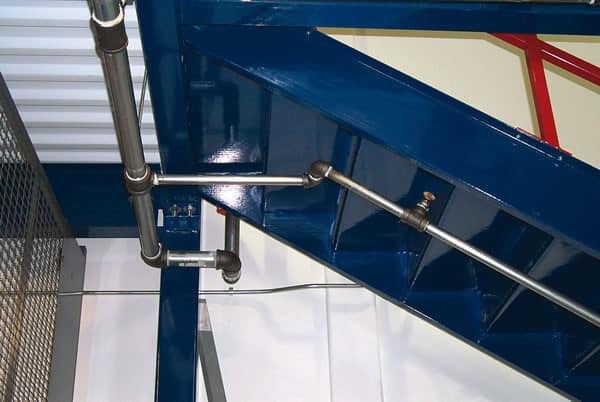
“Blending in” may be preferred where vandalism is likely, but head guards can only do so much
High-visibility colors can prevent accidents—and they are especially useful for heavy-duty head guards that are used in commercial environments where sprinklers are prone to impact—but what about intentional attacks? Sprinkler sabotage happens frequently in prisons and other secure environments. But it can also be a problem in public places: some vandals and people whose curiosity overpowers their common sense find themselves irresistibly drawn to sprinkler heads.
High-contrast colors may draw unwanted attention in scenarios like these. As such, it may be helpful to choose fire sprinklers and guards that blend in. Minimizing color contrast (both between heads and head guards and with the surrounding wall or ceiling) may prove somewhat helpful. But it’s worth noting that other, more secure alternatives are available.
Institutional fire sprinkler heads, which have a low profile and specially-secured parts, are designed with saboteurs in mind. And where vandals are especially determined to damage sprinklers, the Shutgun—a specialty fire sprinkler shutoff tool—can significantly reduce the inevitable water damage if vandalism sets off a sprinkler.
In the absence of clear color requirements for fire sprinkler head guards, installers and consumers manage risk with informed decisions
There are hard limits to what an ordinary sprinkler head cage can do. But in NFPA 13-compliant fire sprinkler systems, these products may be required in certain environments. And when common sense or experience suggests that problems may arise, they’re a modest investment—generally a few dollars per sprinkler—that pays dividends.
QRFS has a selection of standard head guards (both manufacturer-specific and generic) for wall-mounted and ceiling-mounted heads, both recessed and non-recessed. Available in chrome, white, and red, these guards may be used with almost any fire sprinkler with a 1/2” or 3/4” thread connection (with the one major exception being Viking’s new line of XT1 heads, which require specialty head guards). Our catalog includes:
If the sprinkler in question may be exposed to severe impacts—such as a collision with a scissor lift, pipe, or flying soccer ball—consider our selection of heavy-duty head guards. While you’ll want to consult with local fire officials before purchasing or installing them, these extra-large guards are ideal in areas where unwanted activation is costly or where more severe impacts are likely.
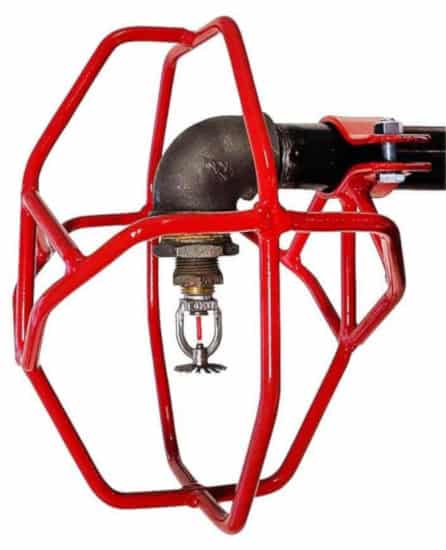
Browse our full selection of fire sprinkler head guards.
Questions? Call us at +1 (888) 361-6662 or email support@qrfs.com.
This blog was originally posted at blog.qrfs.com. If this article helped you, check us out at Facebook.com/QuickResponseFireSupply or on Twitter @QuickResponseFS.


